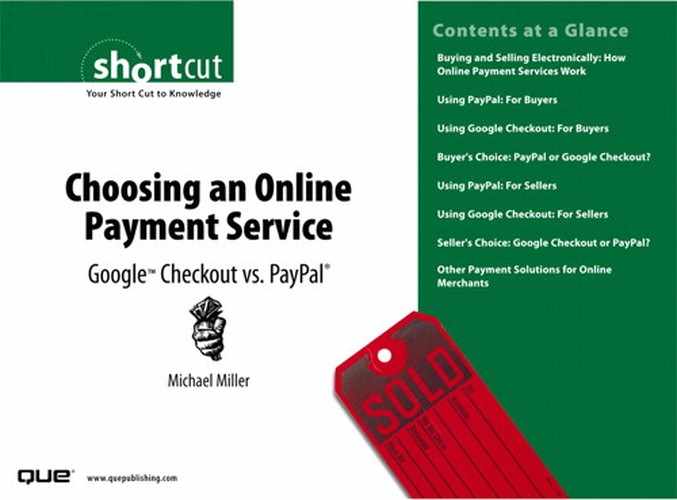Using Google Checkout: For Sellers
Google Checkout is an attractive alternative to PayPal for anyone selling items on a personal website. Your customers get a similar checkout and payment experience, while you end up paying less in transaction fees than you would if using PayPal.
There are drawbacks to using Google Checkout, of course. First, you can use Google Checkout only for domestic orders; at this point in time, it's a U.S.-only service. Second, you can use Google Checkout for sales only on your own website; it's not available for eBay auctions. And third, you can accept only credit card payments; Google Checkout has no provision for customers who want to pay via e-check or bank account withdrawal.
That said, Google Checkout for sellers is similar to the PayPal service, and quite easy to get up and running on your site.
Setting Up a Google Checkout Account
To use Google Checkout for website payments, you first need to sign up for the service. You start this process by going to the Google Checkout for Merchants page (checkout.google.com/sell/) and signing in with your Google Account ID and password. (If you don't yet have a Google Account, now's the time to sign up for one.)
The first thing you see is a page that lets you know what you'll need to create your Google Checkout Account, as shown in Figure 33. You'll also be asked to describe your business. Check the option that best categorizes the type of business you run; then click the Sign In and Continue button.
Figure 33. Before you sign up for Google Checkout—describing your business.

You're now taken to the Contact Information page, shown in Figure 34. You'll need to enter the following information:
Figure 34. Entering your business information.

Enter this information, check that you agree to the terms of service, and then click the Next button. This takes you to the Financial Information page, shown in Figure 35. Now you get to enter even more information about your business:
- Current sales volume
- Estimated average order
- Federal tax ID (EIN) or your Social Security number and credit card information
Figure 35. Entering financial information.

Click the Next button and you see the Public Business Information page, shown in Figure 36. Here, you enter as much information about your business as you like, including
- Website URL
- Types of products you sell
- The business name you want to appear on customers' credit card statements
- Email address and other information for customer support
- Your return/cancellation and shipping policies
Figure 36. Entering even more information about your business.

Click the Finish button and you're signed up—and ready to integrate Google Checkout with your website.
Paying for Google Checkout
How much does it cost you to use Google Checkout? The fee structure is simple. You pay 2% of the total sale price (including shipping, handling, and sales tax) plus 20 cents per transaction. For small and medium-sized merchants, that's significantly lower priced than PayPal's 2.9% plus 30 cents per-transaction fee.
These charges, of course, are deducted from your funds due in your Google Checkout Account.
Integrating Google Checkout with Google AdWords
Here's something that makes Google Checkout even more attractive—and, perhaps, free. If you advertise with Google AdWords, you get a discount on your Google Checkout fees. For every $1 you spend on the AdWords program, you can process $10 in Google Checkout sales for free.
Note
AdWords is Google's web advertising service. When you sign up for AdWords, your text advertisement will appear on related websites from both Google and its partners. Learn more about AdWords at adwords.google.com.
For example, if you spent $100 on AdWords in the previous month, you can process $1,000 in sales through Google Checkout at no cost. Obviously, this is an incentive for you to use AdWords to advertise your website, but it's a useful incentive—one that can save you big money over time.
And once you sign up for Google Checkout, a shopping cart icon will appear next to all your AdWords text ads. This provides a fast track for customers to click your ad and purchase your item, using the Google Checkout system.
Evaluating Google Checkout's Payment Services
Google offers three different ways to integrate Google Checkout with your website. Which service you use depends on the number of items you're selling and how sophisticated your site is:
- Buy Now buttons, designed for smaller merchants and individuals selling a limited number of items. This service lets you use the checkout function on Google's website and requires only a basic knowledge of HTML to implement.
- E-commerce partner integration, which is useful if you're using a shopping card application supplied by one of Google Checkout's partners. At this point in time, Google's partners include ChannelAdvisor, Infopia, Mercantec, MonsterCommerce, Shopsite, and Volusion.
- Google Checkout API, which lets you program your own shopping cart and checkout and then tie your site into the Google Checkout API. This option is for larger merchants only.
Table 4 details the features of these different services.
Table 4. Google Checkout's Online Payment Services

Which option should you choose? If you're a small merchant or individual selling a limited number of items, the choice is simple: go with the Buy Now buttons. If you're a larger merchant with a pre-existing checkout system, the choice is also simple: use the Google Checkout API. And if you happen to already use a checkout system provided by one of Google's merchant services partners—ChannelAdvisor, Infopia, Mercantec, MonsterCommerce, Shopsite, and Volusion—go with the e-commerce partner integration option.
Note
To use the e-commerce partner integration option, you'll need the Merchant ID and Merchant Key assigned to you by Google Checkout. Then go to checkout.google.com/seller/integrate.html and follow the instructions there for integrating with the specific third-party services provider.
For larger merchants, the Google Checkout API is the way to go. This assumes that you already have a shopping cart application installed on your website; you then use the Google Checkout API to tie your system into the Google Checkout payment system. This requires programming expertise, of course, but provides a seamless integration between your site and the Google Checkout system. Learn more at code.google.com/apis/checkout/.
Adding a Google Checkout Buy Now Button to Your Website
For most smaller sellers, the easiest route is to add Google Checkout Buy Now buttons to your website. When a customer clicks on the Buy Now button, he's taken to the checkout system hosted by Google Checkout, where he can pay via credit card.
To add a Buy Now button to your website, sign into Google Checkout, select the Settings tab, and then click the Buy Now Buttons link. This takes you to the Create a Buy Now Button page, shown in Figure 37.
Figure 37. Creating a Buy Now button for your website.

From here, you select a button type (basic button or button with pull-down options list) and button style, and enter your item's name, number, and price. Click the Create Button Code button, and Google generates the HTML code for the button. Copy the code from this page into your web page's basic HTML code, where you want the button to appear, and you're ready to go.
Google Checkout and eBay Auctions
If you're an eBay user who is not a fan of PayPal, you may be curious about switching from PayPal to Google Checkout for your eBay auction payments. Unfortunately, you can't.
On July 6, 2006, eBay announced that Google Checkout didn't meet the requirements for third-party payment services outlined in its Safe Payments policy, thus banning Google Checkout from the eBay marketplace. The reason for the ban? It might have something to do with the part of the policy that states that a payment service must have a "substantial historical track record of providing safe and reliable financial and/or banking related services"; as a new service, Google Checkout doesn't have an historical track record of anything.
Of course, it may also be that eBay doesn't want to encourage a huge potential competitor. By banning Google Checkout from the eBay site, eBay ensures PayPal's continued dominance of the auction payments market.
In any case, you can't use Google Checkout in your eBay auctions—not yet, at least.
Collecting Google Checkout Payments
What happens when someone clicks the Google Checkout Buy Now button on your website? Believe it or not, you don't get notified of the purchase—at least, not by default. Instead, you have to manually check the Orders tab of the Google Checkout Merchant Center. All recent orders will be displayed here.
To view information about a specific order, simply click the order number. You'll now see the order details and have the option of choosing a shipping carrier and entering a tracking number. You'll also need to okay the order and charge the customer's credit card; you do this by clicking the Charge button beside the order.
Tip
If you want to be notified via email of all new purchases, go to the Google Checkout Settings tab and click the Preferences link. On the Order Processing Preferences page, check the option for Email Me Each Time I Receive an Order, Cancellation, or Other Transaction and then click the Save Preferences button.
When you're ready to ship the order, return to the Orders tab and click the Ship button beside the order. This will mark the item as shipped and send an automatic email message to the customer, informing him that the package is on the way.
Withdrawing Google Checkout Funds
Google Checkout automatically deposits all funds due into your bank account electronically. For this to happen, you have to supply your bank account information to Google Checkout. You do this by going to the Settings tab and clicking the Financials link. This displays the Bank Information page; click the Set Up Account button.
When the Bank Account Setup page appears, enter the type of account (checking or savings), bank name, routing number, and account number; then click the Save Account button. Google will now deposit a small amount (a few pennies) into this account; when you see this deposit in your account, return to the Account Verification page and enter the amount deposited. This will verify that the system is working and activate your account for direct deposit.
On an ongoing basis, Google Checkout will initiate payment to your account within two business days of a transaction. Know, however, that it might take up to three additional days for your bank to process the funds transfer. So expect payment from a purchase to show up in your bank account within five days of the original purchase.
Google Checkout's Seller Protection Policy
To protect sellers from online fraud, Google Checkout offers both Chargeback Resolution and Payment Guarantee policies.
Under these policies, Google evaluates all chargebacks filed against your account for potential fraud and reimburses you from claims of unauthorized purchases and non-receipt of goods. Provided your claim is accepted, Google will reimburse you within a week.
Of course, the transaction in question has to meet certain qualifications for you to be protected. In particular,
- You have to ship to the buyer's stated shipping address, using the shipping method specified when the order was placed.
- You have to provide a tracking number or other proof of shipping for transactions less than $250.
- You have to provide the customer's signature for proof of delivery for transactions greater than $250.
- You have to display a clear return policy on your website.
- You must provide all requested documentation to Google within 10 business days of the request.
Google promises to reimburse you from fraudulent chargebacks up to $10,000 per year. If your gross Google Checkout sales exceed $1 million per year (lucky you!), Google will protect you for 1% of those sales.
